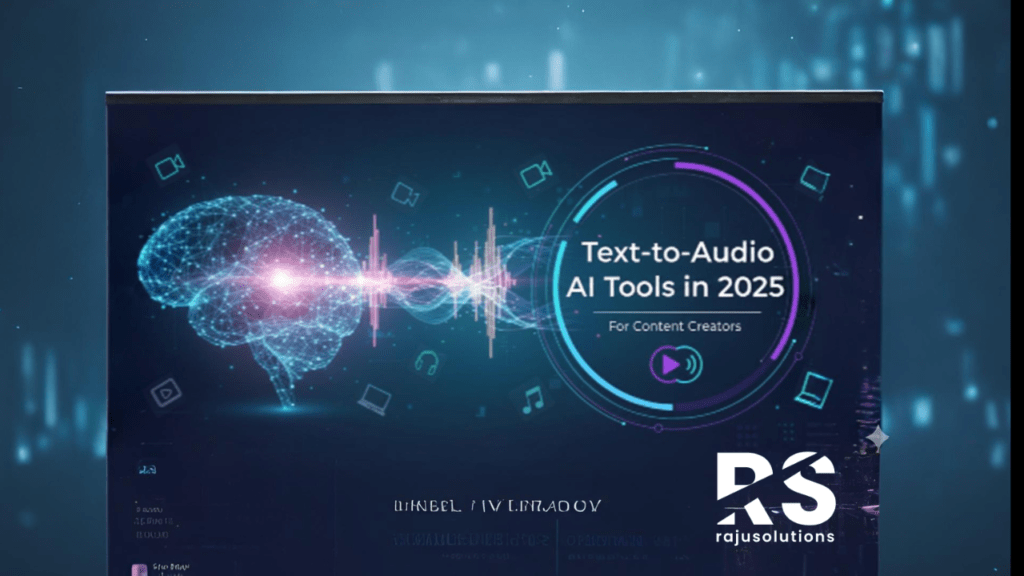
The digital content landscape is rapidly evolving, and content creators are always on the lookout for innovative tools that make content creation faster, easier, and more engaging. Among the most exciting trends in 2025 is Text-to-Audio AI technology — software that converts written text into high-quality, natural-sounding audio. This technology is transforming blogs, articles, eBooks, and other written content into podcasts, audiobooks, and audio blogs, opening up new opportunities for creators to reach diverse audiences.
With increasing demand for audio content consumption, tools that convert text into voice are no longer a luxury but a necessity. They allow creators to repurpose existing content, engage listeners on the go, and expand reach across multiple platforms.
What Are Text-to-Audio AI Tools?
Text-to-Audio AI tools, also known as AI voice generators or AI narrators, are platforms powered by artificial intelligence that automatically convert written content into spoken words. Unlike traditional text-to-speech software, modern AI tools produce human-like, expressive audio that feels natural and engaging.
Key features of these tools include:
- Multiple voice options: male, female, neutral, and various accents
- Natural intonation and pronunciation: making audio sound professional and lifelike
- Customizable pacing and pitch: to suit different content types
- Multilingual support: ideal for creators targeting global audiences
For content creators, these tools offer a time-saving and cost-effective way to produce high-quality audio content without hiring voiceover artists or recording studios.
Why Text-to-Audio AI Tools Are Trending in 2025
Several factors explain why text-to-audio AI tools are gaining rapid popularity:
1. Rising Popularity of Audio Content
Podcasts, audiobooks, and audio blogs are experiencing massive growth. According to recent statistics, over 60% of internet users regularly listen to audio content while commuting, working out, or multitasking. Content creators are adapting by converting blogs and articles into audio formats to reach audiences who prefer listening over reading.
2. Time and Cost Efficiency
Creating audio content manually requires a recording studio, professional equipment, and editing software — all of which can be expensive and time-consuming. AI tools eliminate these barriers, allowing creators to generate audio files in minutes with minimal effort.
3. Content Repurposing
Content repurposing is a key strategy in digital marketing. By converting existing written content into audio, creators can maximize content value, boost SEO performance, and increase audience engagement across multiple platforms.
4. Accessibility
Audio content makes blogs and educational material accessible to visually impaired users and those who prefer listening over reading. Text-to-audio AI tools are enhancing inclusivity in digital content consumption.
Top Text-to-Audio AI Tools for Content Creators in 2025
Here’s a look at some of the best AI tools available in 2025, designed to help content creators produce high-quality audio content efficiently:
1. Descript
Descript combines AI-powered audio generation with editing tools. Its Overdub feature allows creators to clone their own voice or use natural-sounding AI voices. It’s ideal for podcast creators, YouTubers, and bloggers who want to produce consistent, professional audio content.
Key Features:
- AI voice cloning
- Real-time audio editing
- Multilingual support
2. Play.ht
Play.ht is a versatile platform that converts text into natural-sounding audio in multiple languages. It’s suitable for podcasts, articles, and e-learning content.
Key Features:
- Over 600 realistic AI voices
- Embeddable audio players for websites
- Cloud-based audio generation
3. Murf AI
Murf AI is a popular choice among content marketers and educators. Its studio-quality voices and voice customization options allow creators to produce high-quality narrations.
Key Features:
- Voice modulation and pitch control
- Multiple voice languages
- Integration with video platforms
4. Synthesia
While primarily known for AI video generation, Synthesia also offers AI voiceover features, making it a perfect choice for content creators combining audio and video content.
Key Features:
- Human-like AI voices
- Multilingual support
- Syncing audio with AI-generated video
5. WellSaid Labs
WellSaid Labs is designed for professional voiceover production. It offers highly expressive AI voices, suitable for e-learning, marketing, and corporate content.
Key Features:
- Lifelike AI narration
- Cloud-based audio export
- Integration with popular content creation tools
Benefits of Using Text-to-Audio AI Tools
Using text-to-audio AI tools comes with multiple advantages for content creators:
1. Boost Audience Engagement
Audio content engages audiences differently from text. Listeners can consume content while commuting, exercising, or multitasking, increasing reach and engagement.
2. Expand Your Content Reach
By offering content in multiple formats — text, audio, and even video — creators can reach a broader audience, including those who prefer auditory learning.
3. Save Time and Resources
AI-generated audio eliminates the need for recording studios, professional voice artists, and editing software. Content can be produced faster and at a fraction of the cost.
4. Improve SEO and Website Traffic
Embedding audio content on blogs and websites can enhance dwell time, reduce bounce rates, and improve SEO rankings, especially for long-form articles.
5. Support Accessibility
Text-to-audio AI tools make digital content inclusive for visually impaired users, catering to a wider audience and improving compliance with accessibility standards.
Tips for Using Text-to-Audio AI Tools Effectively
To maximize the potential of text-to-audio AI tools, content creators should follow these best practices:
1. Choose the Right Voice
Select a voice that matches your brand tone and target audience. For example, professional blogs may require calm, neutral voices, while entertainment content may benefit from energetic tones.
2. Edit Your Script for Audio
Not all text translates well into audio. Use short sentences, conversational language, and clear punctuation to make the audio sound natural and easy to follow.
3. Use Background Music or Sound Effects
Adding subtle background music or sound effects can make the audio more engaging. Some AI tools allow for music integration directly in the platform.
4. Repurpose Across Platforms
Once generated, audio content can be repurposed for podcasts, social media reels, YouTube narration, and e-learning modules, maximizing content reach.
5. Regularly Update Content
Keep your audio content fresh by updating blogs and republishing audio versions. This maintains relevance and audience engagement.
Future of Text-to-Audio AI Tools
The future of text-to-audio AI is bright, driven by continuous advancements in artificial intelligence and machine learning. Upcoming trends include:
- More natural voices: AI will generate voices indistinguishable from real humans.
- Emotion and intonation control: AI will allow creators to convey emotions, humor, or suspense in audio narrations.
- Integration with AR/VR: Audio content may merge with augmented and virtual reality for immersive experiences.
- Multilingual global content: AI will make it easier to localize content in multiple languages with native pronunciation and accent.
These advancements will empower creators to produce high-quality, engaging audio content at scale, catering to a diverse, global audience.
In 2025, Text-to-Audio AI tools are no longer optional — they are a must-have for content creators who want to stay competitive in the digital space. These tools enable creators to repurpose content, reach wider audiences, enhance engagement, and save time and resources.
Whether you’re a blogger, podcaster, educator, or marketer, leveraging AI tools like Descript, Play.ht, Murf AI, Synthesia, and WellSaid Labs can transform the way you produce and distribute content. By embracing these technologies, content creators can deliver high-quality, accessible, and engaging audio experiences to audiences worldwide.
Stay ahead of the curve — explore Text-to-Audio AI tools in 2025 and make your words speak in ways that truly resonate with your audience.

